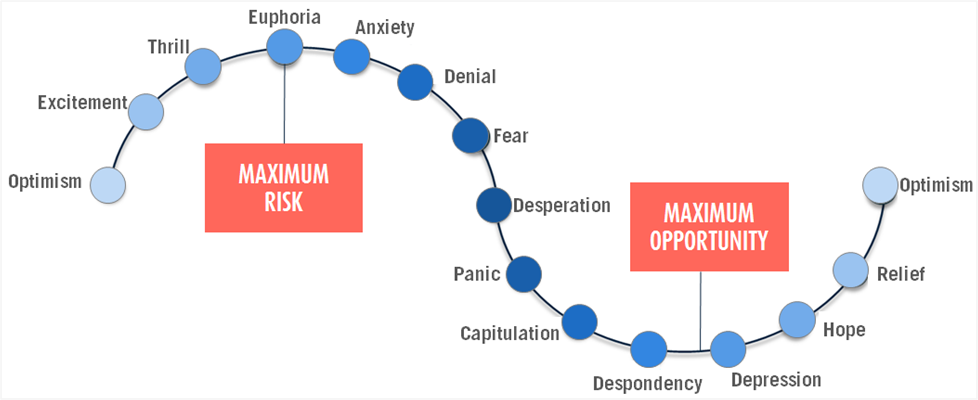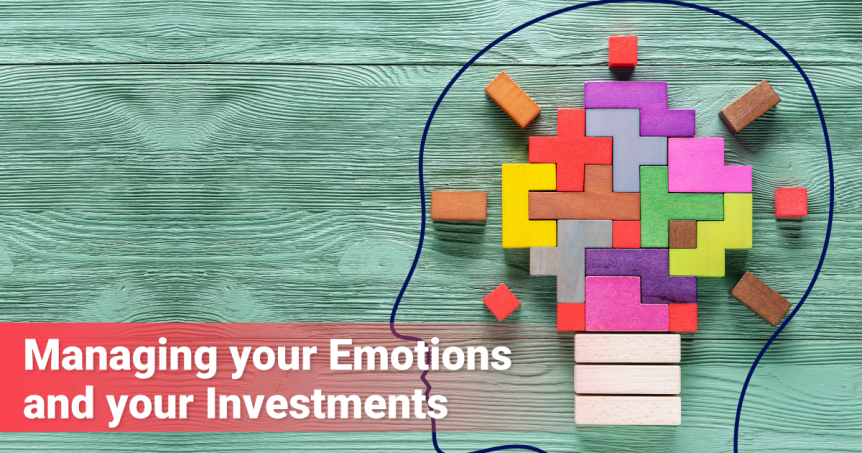We are hardwired to seek out predators and react to warning signals. While this innate behavior may have helped keep our ancestors alive, it also makes it almost impossible to make good investment decisions. Few things make us as emotional as the prospect of losing money. That’s why investing is a continual struggle between logic and emotion.
Cycle of Investor Emotions
The Cycle of Investor Emotions illustrates that when the market begins an upswing, you feel optimistic and as it rises, so do your emotions. Finally as the market hits its high, you enter into a state of total euphoria. Of course, your natural inclination in this state is to buy.
Then, prices drop, just a little, and you begin to feel a little anxious, thinking this couldn’t possibly be happening again. Before you know it, your fear has grown into total despondency and depression and you convince yourself you’d be a fool not to sell.

It’s normal to feel good when the market is up. But you have to remember that the more expensive an asset is, the riskier it is. When you buy at markets highs buy, you are buying at the point of maximum risk. On the flip side, market lows represent the point of maximum opportunity.
Here are 5 tips for becoming a successful do-it-yourself investor
Quantitative Analysis of Investor Behavior
The financial impact of buying high and selling low is best quantified by DALBAR’s study, the Quantitative Analysis of Investor Behavior (QAIB), which compares investor’s returns to relevant benchmarks over a rolling 20 year period.
As you see depicted below, in the 20 year period ending in 2016, the S&P 500 had a return of 7.68%. However, the average investor only got 4.79%, under-performing their investment by a margin of more almost 3%. It’s not just equity investors that fall behind. As you can see, fixed income investors trailed Barclay’s by an even greater distance.

As are all things rooted in the human condition, the causality of the performance gap is as simple as it is complex. Ultimately, it comes down to the fact that it is human nature to want what we can’t have. In this case, the object of our quest is high returns with minimal risk.
The desire for a higher performing yet less painful investment leads you to make crucial investment errors. But your primal urge to avoid loss and pursue gain keeps you so mixed up that you can’t always see this.
Investing Based on Emotions
When you invest based on emotions, you’re simply acting on what you wished would have happened. Sure, everyone wishes they could have reaped the gains of participating in a market upswing. But by the time most investors actually buy, all they’ve actually accomplished is a paying more for an asset than they should have.
Making investment moves based on what you wished would have happened is akin to driving while looking in the rearview mirror. It’s dangerous. And if you do it too long, you’re bound to get hurt.
But you’re only human, so what do you?
Control What You Can and Ignore the Rest
You must fully acknowledge that your investment results depend on your behavior as much as your investment’s performance.
You must also control what you can and ignore the rest. You cannot, nor will you ever be able to control the stock market. Market chaos and media frenzy will always exist and you will always want to react. But the lesson is that you can’t. If you have a history of repeatedly buying and selling at the wrong time – STOP!
Discipline is the best strategy for avoiding paying the high cost of following your emotions. Follow a rule-based system that is designed to address the human condition.
The Snider Investment Method
The Snider Investment Method never relies on emotions or gut feelings to determine when to buy or sell. It works because it is a set of firm rules and steps, repeated deliberately and systematically month-to-month.
Rather than relying on hunches, hope, or hypotheses, a good strategy uses a powerful combination of logic, reason, and probabilities, making it a good fit for both the novice and experienced investors.




